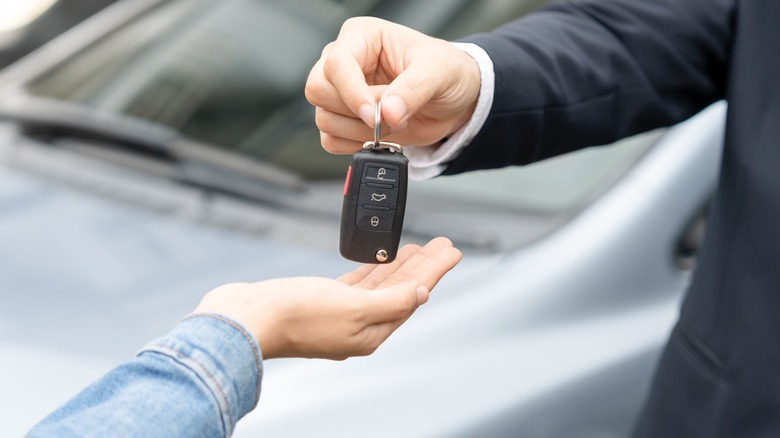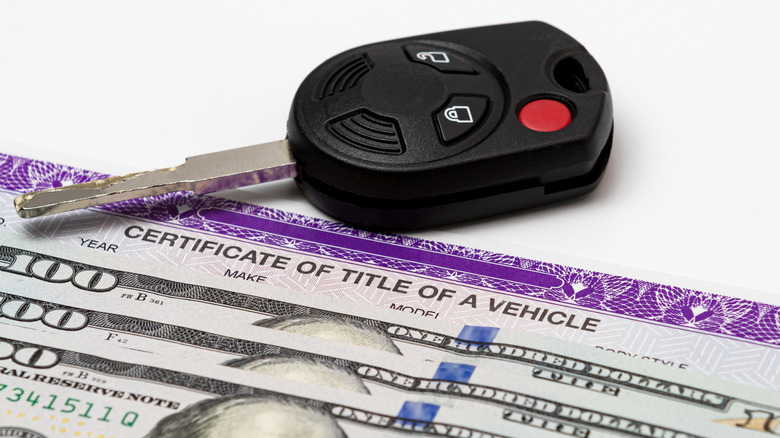Do You Owe More Than Your Car's Resale Value? What To Know Before Accepting A Trade-In Offer
Being upside-down is generally never a good thing. In the case of a car loan, it means you owe more than the value of your ride. This situation isn't unusual if you financed with a high-interest loan. According to the U.S. Federal Reserve, in March 2024, the average new car loan had an interest rate of 6.43%, over 2% higher than three years earlier. The situation gets more grim if you purchased one of the worst car brands for depreciation. Electric vehicles, in particular, are notorious for plummeting resale values compared to cars with internal combustion engines.
While starting fresh with a trade-in on a new car and a new loan may seem to be a way out of the situation, such a move can compound the problem. Unless you're dropping a large amount of cash to offset what you owe on the old car, all you're doing is rolling over the negative equity into new financing. The result is higher payments, a longer loan, or both. Trading in a car without understanding its resale value is a recipe for financial disaster. Rather than just listening to dealer promises, take the time to understand how negative equity works. From there, you can make a more informed decision about whether a trade makes sense for your situation.
How negative equity affects trade-ins
Besides adding to the balance of a new car loan, negative equity can influence your choices for a replacement vehicle. If a dealer knows you're upside down on a loan, they may focus on structuring a deal around a specific monthly payment rather than the best bottom-line price. Not only do you lose negotiating leverage, but you also have less flexibility with car selection, incentives, and interest rates.
Rolling over negative equity into a new loan may also impact the financing terms for a new vehicle. Lenders are all about reducing their risk, so borrowing more than a car's value can result in higher interest rates or shorter loan lengths. This is especially an issue if your credit isn't strong. Another consideration when adding negative equity to a loan is what happens if the new car is totaled in an accident. In this situation, the insurance payout will be based on the market value of your most recently financed vehicle. Without extra-cost gap insurance, you'll be responsible for the shortfall.
Steps to take before trading in an upside-down car
If you've decided to trade in a car with negative equity, there are steps to take to protect your financial interests. Before setting foot into any dealership to look at a new car, get an idea of your current vehicle's value. Operations like CarMax and Carvana offer online appraisals and purchase offers. Reach out to multiple companies as pricing can vary significantly, but be sure to be honest about your car's condition so the offers are accurate. Local dealers may also be willing to buy your vehicle without you making a purchase.
Next, when you're ready to look at new cars (including used vehicles), focus on what you're buying, not what you're trading in. If asked if you're trading in your vehicle, just reply with a simple "no." You can always change your mind. The whole point of this approach is to simplify negotiations and get to the best possible price. Once you're happy with the deal, you can bring up your trade-in, and don't hesitate to shop with competing dealers. Because you've already done the homework by getting third-party purchase offers, you'll know the trade-in's value. You may still be upside down, but you'll have minimized the negative equity as much as possible. If you proceed with a deal, confirm in writing when the old loan will be paid off and for what amount.
There are other ways to avoid or reduce negative equity. For instance, selling your car privately may yield a higher price. And, yes, you can sell a car that hasn't been paid off. You can also postpone your purchase decision and make extra payments on the current car to pay down the loan more quickly.


